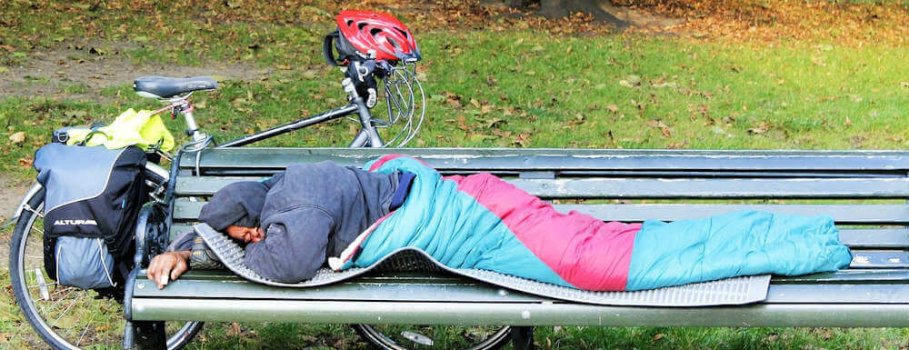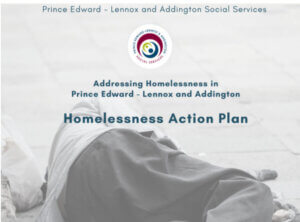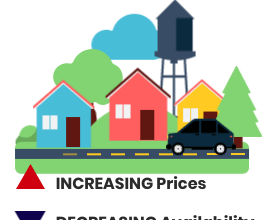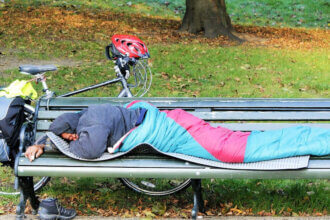Homelessness
Prince Edward County, Ontario, Canada.
Vital Signs Data

Updated September 28, 2023
Rural homelessness is not always evident. It can include living in tents or vehicles, “couch-surfing”, or staying in shelters.
PEC Homeless Point-in-Time Count (PiTC)
A 2018 survey on homelessness in PEC found that 32+ people were considered homeless or precariously housed, including at least 8 children. (Prince Edward-Lennox & Addington Social Services, Report on Homelessness 2018, p. 9) By November of 2021, that number had reached 45+. (Prince Edward-Lennox & Addington Social Services, Point in Time Count Homelessness Report 2021) In general, for every one person identified as homeless, there are between three to five others. The top reasons listed by those surveyed were low incomes, high rents, mental health and addiction issues, abuse and family or landlord conflicts.
In conjunction with the PiTC in 2021, a local By-Name List (BNL) was established. The objectives of a By-Name List include:
• Establishing a systematic approach for matching people to services and supports;
• Prioritizing offers of services, supports and housing to individuals as they become available; and
• Improving coordination and access to local programs, services and resources available for individuals experiencing homelessness.
 Through the Homelessness Action Plan (Sept/23) the counties of Lennox and Addington, and Prince Edward are taking strides to combat homelessness.
Through the Homelessness Action Plan (Sept/23) the counties of Lennox and Addington, and Prince Edward are taking strides to combat homelessness.
Threats to housing stability
With rising inflation and interest rates, two in five Ontarions (42%) are just $200 away from financial insolvency. (MNP Consumer Debt Index October 2022)
Locally, in addition to soaring rental and inflation rates, “renovictions” are forcing out tenants as neighbourhoods undergo gentrification.
of Ontario residents are $200 away from insolvency
“More people are reaching out for support from eviction prevention and rental assistance programs, with many in danger of becoming homeless. Social assistance rates far below the poverty line and lack of technology access are barriers for the most vulnerable people who need to reach legal resources and communicate during COVID-19.”
Lisa Turik, Community Advocacy and Legal Centre
Causes of homelessness
The causes of homelessness are complex and can be broken down into three categories: (homelesshub.ca)
Structural factors, such as economic and societal issues that affect opportunities, environments, and outcomes for individuals. This includes poverty, discrimination, lack of affordable housing, and the impact of colonialism on Indigenous Peoples.
Systems failures, where systems of support are inadequately delivered. Barriers to accessing public systems (health, social services, and legal supports), and failed transitions from publically funded institutions (child welfare, hospitals, and corrections) are examples of systems failures.
Individual and relational factors where personal circumstances, such as crises (like sudden unemployment or a house fire), mental health and addiction, housing insecurity, and interpersonal violence, can lead to homelessness.
Community resources
- Community Advocacy and Legal Centre (CALC)
Housing problems are often linked to low income, discrimination, and job loss. CALC is a non-profit community legal clinic that provides free services to people living on a low income in Hastings, Prince Edward, and Lennox & Addington counties and Tyendinaga Mohawk Territory. They have many satellite offices throughout the three-county service area.
communitylegalcentre.ca/legal-topic/housing-law/ - Prince Edward-Lennox & Addington (PELA) Social Services works with individuals to help prevent homelessness, and they organize a homeless enumeration every two years.
www.lennox-addington.on.ca/social-services - Kate’s Rest on Big Island is a property that provides permanent housing for people who are at risk of homelessness.
www.katesrestfoundation.ca/ - Alternatives for Women assists with transitional housing for victims of domestic violence.
www.alternativesforwomen.org/ - Youth Habilitation Quinte Inc. is a community based non-profit organization helping young people living in the Quinte area obtain and maintain safe and affordable housing, good mental health and employment. www.youthab.ca
- Emergency overnight accommodations during extremely cold conditions are available through the local Salvation Army 613.476.3159
- The HOPE Centre in Picton (First Baptist Church) provides a warming centre during the day, warm meals and coffee, as well as “blanket boxes” with free blankets and sleeping bags outside the church for those in need. From Dec 15 to March 15 (starting in Dec 2023), the centre will remain open overnight from 8pm to 8am. https://www.facebook.com/The-HOPE-Centre-647799381985481
Sustainable Development Goal (SDG) 11.1
SDG 11.1 Ensure access for all to adequate, safe and affordable housing.
Also see …
Household Characteristics
Private dwellings with single occupancy, single parent families;…
Affordable Housing
Impact; Affordable housing developments; What is being done
Owning
The housing shortage and high prices, coupled with…
Renting
Similar to the purchasing market, overbidding in the…
Homelessness
Homeless count, threats to housing stability, homelessness facts,…
Housing – Actions
Housing: Advancing well-being together: County Housing Plan, Exploring…










